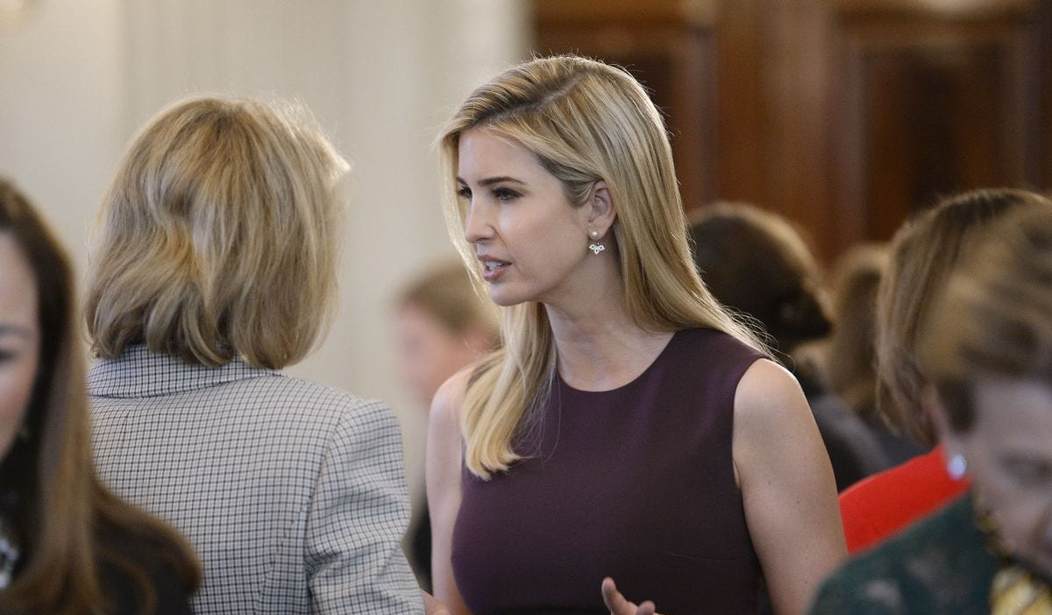On Tuesday, women and men across America commemorate “Equal Pay Day,” which purportedly represents how far into 2017 women must continue working in order to earn what their male counterparts earned last year. But the claim that women experience pay discrimination is tenuous at best — the 79 cents on the dollar statistic applies to all men and all women, not a true side-by-side comparison of pay for equal work — and government is more likely to cause more problems if employed to fix the “gender gap.”
Still, people from across the political spectrum promoted Equal Pay Day.
“#EqualPayDay is a reminder that women deserve equal pay for equal work. We must work to close the gender pay gap!” tweeted Ivanka Trump, President Donald Trump’s daughter.
#EqualPayDay is a reminder that women deserve equal pay for equal work. We must work to close the gender pay gap! https://t.co/CcwsoBXWdF
— Ivanka Trump (@IvankaTrump) April 4, 2017
California Senator Dianne Feinstein declared, “In 1963, women earned $0.59 for every $1 earned by men. In 2017, women earn $0.79 for every $1 earned by men. We must do more.”
In 1963, women earned $0.59 for every $1 earned by men. In 2017, women earn $0.79 for every $1 earned by men. We must do more. #EqualPayDay
— Senator Dianne Feinstein (@SenFeinstein) April 4, 2017
LeanIn.org even launched a “#20PercentCounts” campaign, partnering with businesses across the country to provide women a 20 percent discount on everyday items. The ride-sharing service Lyft even announced that it would be donating 20 percent of ride proceeds on April 4 to organizations for women.
This #EqualPayDay, we're partnering w/ @LeanInOrg to donate 20% of ride proceeds to orgs for women: https://t.co/y9cEYD0yaf #20PercentCounts pic.twitter.com/PazS3YHmbL
— Lyft (@lyft) April 4, 2017
Women aren’t the only ones calling for equal pay. Delaware Senator Chris Coons suggested that Congress should pass equal pay legislation on April 4.
April 4 is #EqualPayDay. What better time to pass the #PaycheckFairness Act?
— Senator Chris Coons (@ChrisCoons) April 4, 2017
AFL-CIO President Richard Trumpka declared that “#EqualPayDay is not a celebration, it’s a reminder of how imbalances in our economy cause real pain. Even more for women of color.”
#EqualPayDay is not a celebration, it's a reminder of how imbalances in our economy cause real pain. Even more for women of color.
— Richard Trumka (@RichardTrumka) April 4, 2017
Even the X-Men star Hugh Jackman jumped on board, tweeting, “#20 percent counts Equal pay for women – today and every day. #LeanIn.”
#20percentcounts Equal pay for women – today and every day. #LeanIn pic.twitter.com/lVcZrSTQKg
— Hugh Jackman (@RealHughJackman) April 4, 2017
But just as men joined with women to promote the equal pay argument, many women actually disagreed.
“Feminist groups, Democratic lawyers, and individuals like Sheryl Sandberg, who launched #20PercentCounts retail campaign to offer discounts to women on Equal Pay Day, continue to rely on the faulty wage-gap statistic to trick women into thinking America is overwhelmingly sexist and they are doomed to being consistently shortchanged compared to their male counterparts,” Carrie Lukas, managing director at the Independent Women’s Forum, declared in a statement.
Lukas noted “data proving otherwise,” an homage to the argument that the real reasons women make less than men have more to do with lifestyle choices than wage discrimination.
#EqualPayDay—a day when some cont to rely on the faulty #wagegap stat to trick women into thinking America is sexist https://t.co/qVnQ0xaZm6 pic.twitter.com/qyKokLTxXn
— IWF (@IWF) April 4, 2017
As Andrew Biggs and Mark Perry, economists and scholars at the American Enterprise Institute, pointed out in an article for RealClearMarkets, “The reality is that men and women make very different career and work choices, and frequently play very different family roles, especially for families with children. These choices reasonably account for most of gender differences in earnings and don’t point toward widespread gender pay discrimination in the workplace.”
Biggs and Perry pointed to two major factors contributing to wage differences: the skills and productivity gap; and the “compensating wage differentials” that result in higher pay for more demanding or risky jobs.
“Data show that male employees tend to have more years of work experience than females, and also work more hours per week on average than women,” the economists explained. “Men also tend to gravitate toward college majors with greater market value than women.” Biggs and Perry noted statistics showing that about 80 percent of engineering and computer science major are male, while two-thirds of liberal arts, drama, dance, and education majors are female. Furthermore, women are more likely to take extended leaves of absences to care for children, even if they do rejoin the workforce later.
When it comes to “compensating wage differentials,” men are more likely than women to take certain forms of lifestyle hits for work. The economists noted that the average American male spends 4,500 more minutes commuting to work each year — that’s the equivalent of nine eight-hour days sitting in traffic or waiting on public transit.
Men are also more likely to take risky jobs. The 20 jobs with the highest occupational fatality rates tracked by the Bureau of Labor Statistics are on average 93 percent male, while safer jobs (office and administrative support and education, training, and library occupations) are roughly three-quarters female. Is it really unreasonable for people who take dangerous jobs to make higher salaries?
Similarly, there are certain benefits associated with risk-averse jobs. Employees might accept a lower salary if their job is more rewarding, and 70 percent of nonprofit jobs focused on advocacy for a cause employees believe in are held by women.
Biggs and Perry are men, so some will dismiss their arguments as “mansplaining.” But it would not be so easy to dismiss Julie Borowski, a female libertarian YouTube star who asked a very pertinent question, “What do you prefer: a low paying job that you love or a high paying job that you hate?”
“My guess is that many men and women would answer that differently,” Borowski argued. She suggested that, on average, more women would opt for a job they love despite low pay, while more men would value pay over work they love.
“As a woman, I never felt the pressure to be the breadwinner,” the YouTube star explained. “Don’t get me wrong. I’ve always felt pressure to be successful (and I’m glad for that), but money isn’t the only way to measure success. I’ve had more freedom to explore fulfilling and meaningful careers. I’m certainly not rich as an Internet political commentator, but I get by and love what I do. I know I can make more money elsewhere, but I likely wouldn’t enjoy it as much” (emphasis added).
Tellingly, Borowski added, “Women like me are the reason for the gender wage gap.”
“This is my message for #EqualPayDay. Money isn’t the only thing to consider,” the YouTube star concluded. “Women have higher job satisfaction. Men have more workplace fatalities. And keep in mind, that the 77 cent wage gap statistic is not comparing women and men in the same field or job. It’s just overall median wages. It tells us that men and women tend to gravitate towards different careers, and there’s not necessarily anything wrong with that.”
"What do you prefer: a low paying job that you love or a high paying job that you hate?"My guess is that many men and…
Posted by Julie Borowski on Tuesday, April 4, 2017
Imagine — people making different choices in the land of the free! After all, it is illegal to discriminate on the basis of sex when it comes to wages — and has been since 1963.
One final note. There are two ways to combat the gender gap: through government and through economics. If Lukas, Biggs, Perry, and Borowski are correct and the gap is not evidence of widespread pay discrimination, then efforts like the “20 Percent Counts” retail push are misguided — but at least they are private initiatives, not directed by the government.
There’s nothing more dangerous for liberty than a government-directed one-size-fits-all policy on work or wages. Americans should be free to value better work conditions over pay or vice versa. The ultimate goal of the equal pay myth is to take freedom away from the people and hand it to the government, and that is something every American should watch out for.








Join the conversation as a VIP Member